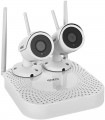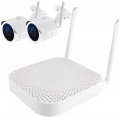Matrix size
The physical size of the sensor in the pointed cameras is diagonally, in inches (fractions of an inch).
The larger the sensor, the less prone it is to noise, the better image quality it can provide, and the better it is suited to low light conditions. This is due to the fact that each individual pixel gets more light, because. on a large matrix and individual dots are larger. On the other hand, large matrices are more expensive.
Number of megapixels
Sensor resolution of pointed cameras in megapixels (millions of pixels).
Higher resolution allows you to get a more detailed "picture". However, increasing the number of megapixels without increasing the sensor size can result in poor overall image quality and noise, especially in low light. Therefore, in itself, the high resolution of the matrix does not guarantee high quality shooting.
Horizontal viewing angle
The viewing angle of the directional cameras supplied as standard is horizontal.
Wide viewing angles allow you to cover a large area; this is especially important given that directional cameras are often made stationary. On the other hand, all other things being equal, a larger viewing angle will mean a lower degree of magnification - objects will look smaller, detail will be worse. Therefore, when choosing according to this parameter, you should proceed from what is more important - a wide field of view or “range”.

